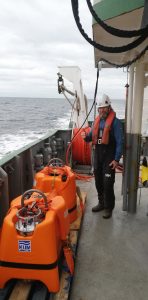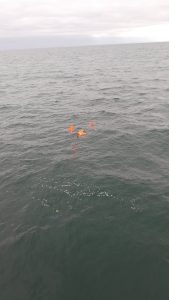Distributed Acoustic Sensing (DAS) as an alternative to currently available technologies for seismic investigations


Andy Trafford beside the 2 NAMMU OBS’s before deployment
Cruise no. CV21009 (March 2021) was part of collaborative research between the SFI Research Centre for Applied Geosciences (iCRAG) and OptSense, led by iCRAG researchers Andy Trafford and Dr. Shane Donohue. The purpose of the research is to assess the feasibility of using Distributed Acoustic Sensing (DAS) as an alternative to currently available technologies for seismic investigations.

NAMMU OBS at the surface ready for recovery
The aim of the project is to develop a methodology using DAS for rapidly acquiring offshore seismic data over considerable distances (km scale), at high resolution. The survey involved the deployment of a 1,000 m (1km) fibre optic cable on the seabed and the use of a 12 cu. in. Sercel Mini G. Air Gun as a source. The cable was deployed at 6 locations in the North Irish Sea where existing data (e.g. cone penetration testing or CPT) exists. Also, 15 sparker seismic lines were recorded and 5 gravity cores retrieved to help characterise the sub seabed at these locations and supplement the DAS data. The research will focus on the Multichannel Analysis of Surface Waves (MASW) method to determine geotechnical properties of the shallow subsurface.
The aim of the project is to develop a methodology using DAS for rapidly acquiring offshore seismic data over considerable distances (km scale), at high resolution.
As part of the survey, two of the iMARL’s OBS NAMMU were deployed alongside the fibre optic cable, as well as two of the iMARL’s Enduro pressure sensors directly clamped on the cable. The overlapping of those instruments with the DAS will provide substantial information towards the combined interpretation of the seismo-acoustic signals with the strain measurements recorded by the DAS system at the seafloor. In addition, the data generated will be used for indepth characterisation of the passive ocean induced seismic noise recorded in the survey area.




